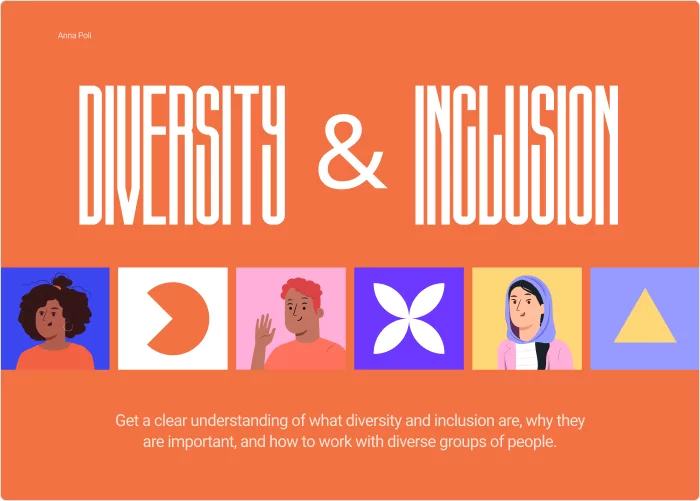Multimodal Learning: A Transformative Approach for Success

Unlike traditional unidimensional teaching methods, multimodal learning embraces a spectrum of channels, such as infographics, podcasts, videos, and simulations, to deliver information. It transcends the boundaries of mere auditory or visual instruction, aiming to engage learners through a dynamic fusion of modalities.
In this article, we’ll explore the essentials of multimodal learning, the benefits it brings to businesses, the most popular strategies you can incorporate, and how to launch such learning programs at your organization. Let’s get started.
What is Multimodal Learning?
Multimodal learning is a type of learning that involves using multiple modalities. Modes are channels through which you deliver new information. They can include any informational format that provides new knowledge.
For example, instead of just giving a salesperson a text on how to convert prospective clients, you can create an eLearning course that includes several modes: text-based slides, images that complement key ideas, a voice-over, and a role-play simulation in which learners can see how clients react (in gestures, facial expressions, and replies) to their communication strategy.
Benefits of Multimodal Learning
They say, “A picture is worth a thousand words.” Multimodal learning has a different perspective. Instead of pursuing a single most effective information channel, it achieves learning goals by combining various channels to accommodate the learning style of every employee. Multimodal learners see, hear, read, and interact with information in many ways, which helps them grasp new knowledge faster and retain it longer.
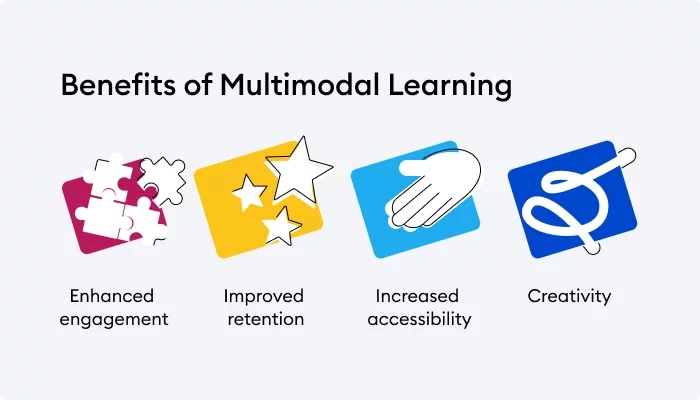
Let’s look at some of the key benefits of multimodal learning:
Enhanced engagement
We might like our daily routines, but it’s still human nature to look for something new, something unusual, or something entertaining. When we see, hear, or do the same thing over and over, we get bored. And when we’re bored, the learning process becomes torture and has little or no effectiveness. Multimodal learners are engaged learners, and engaged learners are productive employees.
Improved retention
Training professionals incorporate multimodal learning not only because it’s more fun but because, being more fun, it helps people learn better and retain new knowledge.
Moreover, all of us have different learning styles. With a wide variety of information channels, learners can process new knowledge in the way that suits them best, which increases both retention and comprehension.
Increased accessibility
People have different learning abilities, and by introducing several formats, multimodal learning makes learning more accessible for all of them. For example, a person with a visual impairment can’t read texts on slides, but they can still learn if you add a voice-over to your course.
Creativity
Multimodal learners get the fusion of various formats, which encourages them to create new connections, experiment, and use creative thinking to solve problems. This makes them even more valuable to organizations that prioritize innovation.
Types of Multimodal Learning
There are no types of multimodal learning, strictly speaking. There are learning methods it entails, and these methods address different learning styles.
What is a learning style?
A learning style is a unique way that each of us learns best. Some people prefer reading a book, and others would rather listen to a speaker explain a subject. For other learners, it would be best to read some information, then listen to the explanation of a particular concept, and also see some illustrations. Such preferences comprise different learning styles.
One of the most popular models for categorizing and explaining multiple learning styles is the VARK model, developed by Neil Fleming.
The VARK model
The VARK model introduces 4 types of learning styles: visual, auditory, reading/writing, and kinesthetic.
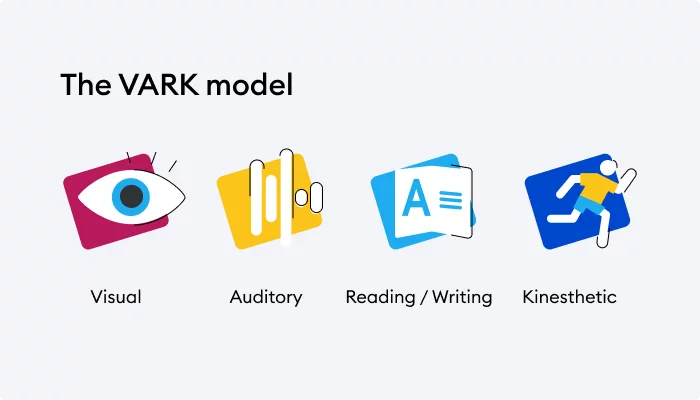
Let’s take a closer look at each of them:
V – Visual
Some people learn better by seeing new information. Visual learners respond well to videos, graphics, illustrations, diagrams, and other visual content.
A – Auditory
Auditory learners thrive in environments where information is communicated through spoken words, lectures, discussions, and audio materials.
R – Reading/Writing
Enthusiasts of reading and writing absorb knowledge effectively through textual materials, notes, and reflective writing assignments.
K – Kinesthetic
Kinesthetic learners flourish when engaged physically, such as through experiments, simulations, hands-on experience, and interactive activities.
This model is insightful and handy, and that’s why it’s become so popular. However, critics of the VARK learning style model raise several concerns:
- Oversimplification. The model’s four distinct categories oversimplify the complexities of multiple learning styles, overlooking individuals’ diverse preferences that often blend across categories.
- Limited consideration of context and content. It fails to sufficiently account for how contextual factors and specific subject matter influence learning styles, which can vary based on complexity and prior knowledge.
- Neglect of diverse individual differences. This learning style model focuses primarily on sensory preferences and overlooks some crucial factors, like cognitive styles, personality traits, and cultural backgrounds, which shape learning significantly.
- Reinforcement of fixed mindsets and stereotypes. Critics worry that the model might reinforce fixed mindsets and stereotypes about learners’ capabilities and preferred learning styles, potentially limiting the exploration of alternative strategies.
Still, the VARK model offers valuable insight into multimodal learning. While critics highlight its limitations, the model’s categories can serve as a foundation for crafting and implementing more comprehensive and effective multimodal learning strategies.
Multimodal Learning Strategies
Multimodal learning strategies range from video-based tutorials and interactive assessments to simulations, written resources, audio-based learning, collaborative platforms, and blended learning approaches. Each strategy harnesses specific strengths, catering to varied learning preferences and corporate training needs.
Let’s explore these strategies and examples of multimodal learning in the corporate setting.
1. Video-based learning
Video-based learning is compelling due to its ability to merge visual and auditory stimuli, engaging learners effectively. Microlearning videos, offering concise information, suit fast-paced environments where employees need quick, digestible knowledge. Interactive videos, allowing participation, enhance engagement and retention for those who have a visual learning style. Webinars, especially live sessions with experts, foster real-time interaction and discussion and are ideal for exploring complex topics or industry trends.

Best use cases:
- Software training. Microlearning videos for software tutorials provide step-by-step guidance.
- Soft skills development. Interactive videos can simulate communication scenarios for training in negotiation or conflict resolution.
- Thought leadership sessions. Live webinars hosted by industry leaders can cover market insights, fostering discussion and learning.
2. Interactive assessments
Interactive assessments offer an engaging way to gauge understanding and skills. Their adaptability and diverse question formats make assessments more comprehensive. Drag-and-drop or interactive quizzes suit topics with process-oriented learning, requiring learners to actively apply knowledge.
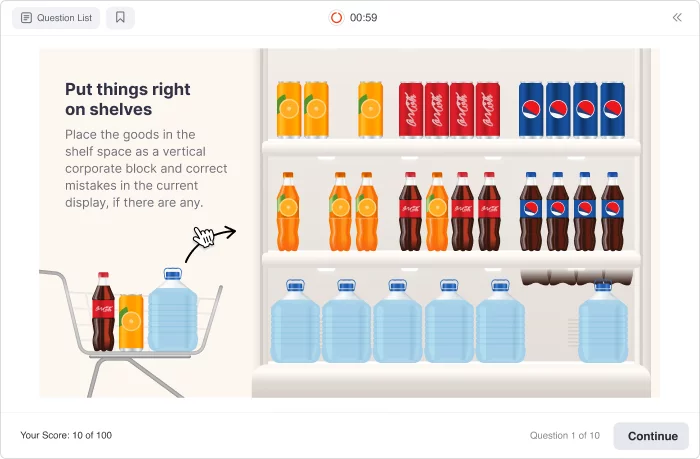
Best use cases:
- Knowledge assessment. Assessments are a crucial part of any learning program, allowing you to check how well learners grasp a subject.
- Knowledge reinforcement. Quizzes are useful not only for assessing learners’ knowledge and skills but also for reinforcing new knowledge. For example, you can add a short quiz after providing a large block of information to help learners look back at the subject and remember it better.
3. Role-play simulations
Role-play simulations create immersive, lifelike environments for experiential learning. They replicate real-world scenarios while providing kinesthetic learners with a safe space for practice and experimentation. Simulations allow learners to apply theoretical knowledge in reproductions of real-life situations, thus enhancing decision-making and critical thinking skills.
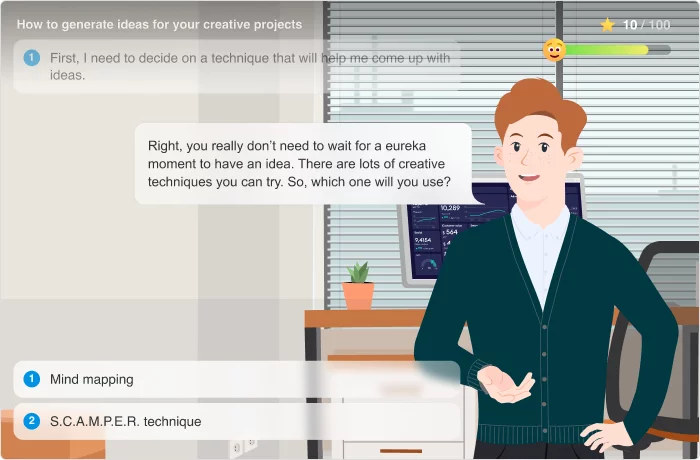
Best use cases:
- Compliance training. For example, you can create a fire safety simulation in which learners need to decide where to go and what to do during a fire in the office building.
- Customer service training. Employees can practice client interactions and conflict resolution in a risk-free multimodal learning environment.
Also read: Role-Play Training
4. Written material and reading resources
Written resources complement other modalities, offering deeper understanding and serving as references for self-paced visual learning. E-books provide comprehensive guides for detailed topics, while curated articles or blogs offer diverse perspectives and real life examples.
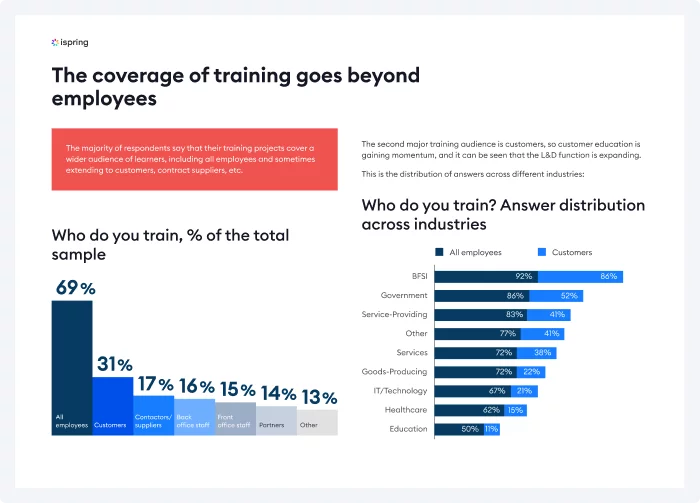
The image above is a screenshot from our research on employee resistance. Feel free to download the complete research documentation.
Best use cases:
- Deep dives. E-books for comprehensive training on specialized subjects.
- Practical insights. Articles or blogs on case studies, showcasing real-life applications.
5. Auditory learning
Catering to auditory learners, audio-based learning suits those who prefer learning through listening. Podcasts or narrations facilitate learning on the go, allowing flexibility in learning environments. They’re effective in delivering information in a conversational tone, making complex concepts more accessible.
Best use cases:
- Commuter learning. Podcasts on leadership, management, or industry updates for learning while traveling.
- Accessibility enhancement. Audio narrations with accompanying visuals for inclusive multimodal learning experiences.
6. Social and collaborative learning
Encouraging interaction through forums, group projects, or case studies fosters collaboration and peer learning. It promotes a sense of community and allows for diverse perspectives, enhancing understanding and problem-solving skills.
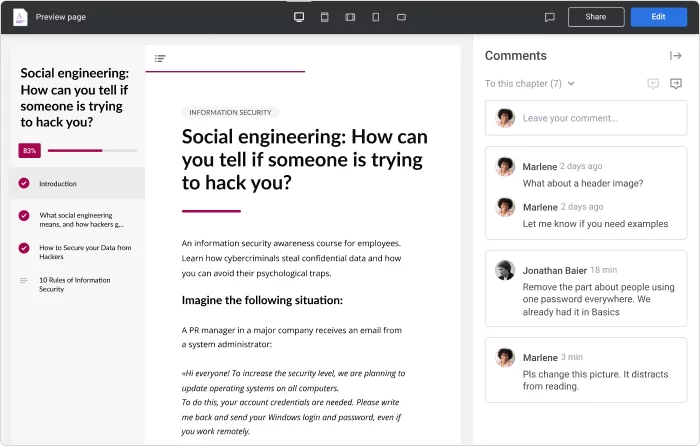
Best use cases:
- Cross-departmental collaboration. Online forums for sharing insights and solutions across teams.
- Team-based problem-solving. Collaborative projects or case studies for tackling real-world challenges together.
7. Blended learning
Blended learning combines the strengths of in-person and online instruction. It integrates various modalities seamlessly, fostering a flexible learning environment. It often involves a mix of instructor-led sessions, online modules, practice-based kinesthetic learning, and self-paced activities.
Best use cases:
- Skill reinforcement. Combining in-person workshops with online modules for continuous learning and practice.
- Hybrid training programs. Integrating in-person sessions or kinesthetic learning sessions with self-directed online learning for flexibility and depth.
Learn more about blended learning techniques.
How to Launch Multimodal Learning with iSpring
Now that you know what the key concepts of multimodal learning are, why organizations support multimodal learning, and which strategies are most popular, let’s get practical and talk more about implementing multimodal learning in your organization.
Here’s how to launch multimodal learning with iSpring LMS (learning management system), our online training platform that has everything you need to create and deliver multimodal learning programs and assess their effectiveness.
Step 1: Create multimodal training content
Using iSpring Suite, an authoring tool that comes bundled with iSpring LMS, you can create impactful eLearning content. Depending on your strategy (visual learning, auditory learning, educational games, etc.), you can create training courses with a voice-over, role-play simulations, training videos, slides with interactive modules, quizzes, etc.
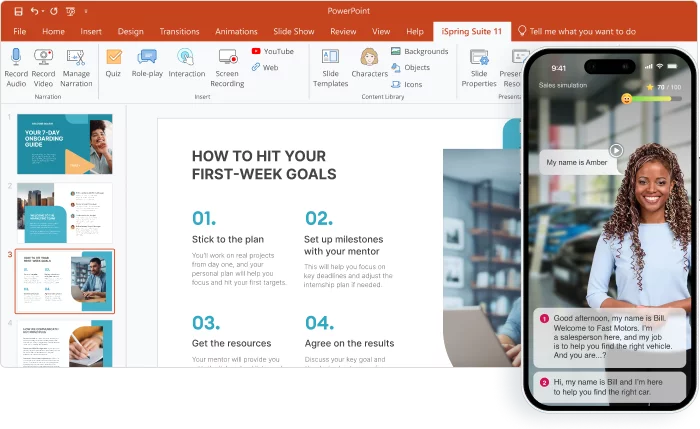
Tips:
- Include different types of course content to suit different learning styles — videos for visual learners, quizzes for active participation, and more.
- Ensure that your content is accessible to everyone by adding closed captions, descriptions for images, and other accessibility features.
Step 2: Create personalized learning paths
Once your content is ready, upload it to iSpring LMS and organize it into learning paths. This will help you provide learners with a comprehensive learning experience that they can take at their own pace.
For example, you can curate a short introductory video, multimedia presentations with interactions, a scenario, and a quiz in a single learning track, and learners will take it part by part.
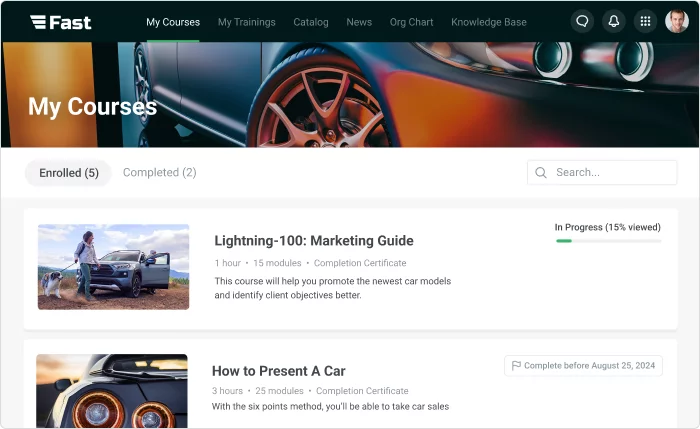
You can create personalized tracks for specific subjects or roles. For instance, you can create a multimodal learning program for onboarding new employees or a skill development program for the sales team.
Step 3: Assign, assess, and optimize
Simply select the learners that need to take a training program, and iSpring LMS will do the rest: notify them about the new assignment, remind them of upcoming deadlines, and track student progress, providing you with detailed reports on every learner, department, and the entire company.
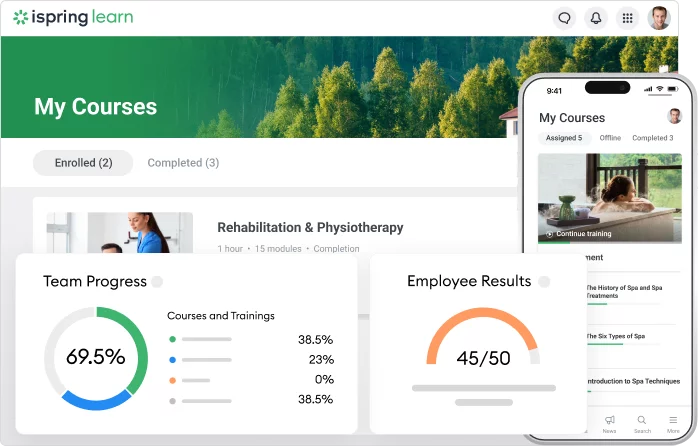
Gather feedback from learners to understand their experiences and what could be improved. See if your multimodal learning strategy has proved effective, and if not, optimize it for better results.
Regularly update content and paths to keep things fresh and relevant.
Wrap Up
Multimodal learning is probably the most adequate approach for educating learners in today’s world. Its multifaceted approach, encompassing various sensory modes, not only fosters enriched engagement but also caters to the multiple learning styles and abilities of individuals, making it accessible, personalized, and extremely effective.
Depending on your learning audience and training needs, you can employ diverse multimodal strategies — ranging from video-based tutorials to role-play simulations, interactive assessments, and collaborative platforms — and craft immersive, tailored learning experiences.
What can you do now?
Test-drive tools like iSpring Suite and iSpring LMS to create and share a multimodal learning program and measure its effectiveness. If you want to see iSpring LMS in action and explore how it can help you accomplish your learning goals, book a free live demo.
FAQ
What is an example of multimodal teaching?
A trainer begins with a presentation discussing communication strategies. They show videos of successful interactions, lead group discussions on active listening, and share written materials outlining key points. Then, they organize role-playing training sessions where employees practice different communication scenarios. Teams collaborate on a project, crafting a presentation that demonstrates effective communication techniques. Finally, the trainer encourages employees to apply these skills in actual work scenarios and shares resources for further learning.
What are the benefits of multimodal learning in preschool?
Multimodal learning in preschool engages multiple senses, like sight, hearing, and touch. It helps students learn better, remember more, and stay more engaged in learning. Using different learning modalities, like seeing and doing, supports diverse learning styles and skills, like motor skills and problem-solving. It also makes learning more inclusive for kids with different needs. Overall, it sets a sound foundation for their future education.
What are the disadvantages of multimodal learning?
It can be complicated to coordinate multiple learning modalities when utilizing multimodal learning, as it requires more resources like time and materials. Processing various channels simultaneously might overload the students’ cognitive abilities, and not all learners benefit equally from each modality. It often relies on technology, which can lead to accessibility issues and increased costs. So, it’s essential to select the right LMS for your training project.
